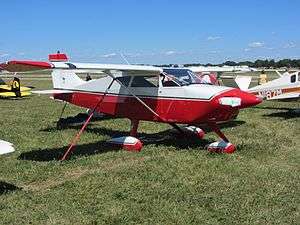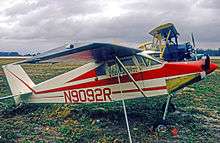Nesmith Cougar
| Nesmith Cougar | ||
|---|---|---|
 | ||
| Role | Recreational aircraft | |
| Manufacturer | Homebuilt | |
| Designer | Bob Nesmith | |
| First flight | 1957 | |
| Introduction | 1957 | |
| Unit cost |
approximately $2750 to build in 1971[1] | |
| Variants | Eaves Cougar 1 | |
| |}
The Nesmith Cougar is a light aircraft that was developed in the United States in the 1950s and marketed for homebuilding.[2] DevelopmentThe design, by Robert Nesmith, is a conventional high-wing, strut-braced monoplane with fixed tailwheel undercarriage. The pilot and a single passenger were seated side by side. The fuselage and empennage were of welded steel-tube construction, while the wings were of wood, and the whole aircraft was fabric-covered. Some later aircraft were fitted with a tricycle undercarriage.  Cougar fitted with conventional tailwheel undercarriage The original Cougar design was marketed by Nesmith himself. His intent was to market a low-cost aircraft for homebuilders. He also used the aircraft as a troubled youth project to encourage teens to work together toward a goal.[3] When a modified Cougar won an Experimental Aircraft Association (EAA) design competition in 1963, that organization took over selling plans. Rights to the design were eventually purchased by Acro Sport. The aircraft shape was influenced by the Beechcraft Staggerwing and Wittman Tailwind. The name came from the college of Nesmith's daughter, the University of Houston, whose athletic mascot is a cougar.[4] Variants
Specifications (typical)Data from Sport Aviation General characteristics
Performance
See also
References
| ||